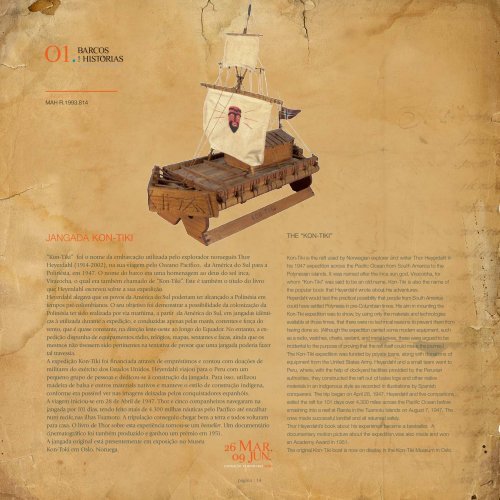Versão digital - Museu de Angra do Heroísmo
Versão digital - Museu de Angra do Heroísmo
Versão digital - Museu de Angra do Heroísmo
You also want an ePaper? Increase the reach of your titles
YUMPU automatically turns print PDFs into web optimized ePapers that Google loves.
JANGADA KON-TIKI<br />
MAH R.1993.814<br />
JANGADA KON-TIKI<br />
“Kon-Tiki” foi o nome da embarcação utilizada pelo explora<strong>do</strong>r norueguês Thor<br />
Heyerdahl (1914-2002), na sua viagem pelo Oceano Pacífico, da América <strong>do</strong> Sul para a<br />
Polinésia, em 1947. O nome <strong>do</strong> barco era uma homenagem ao <strong>de</strong>us <strong>do</strong> sol inca,<br />
Viracocha, o qual era também chama<strong>do</strong> <strong>de</strong> “Kon-Tiki”. Este é também o título <strong>do</strong> livro<br />
que Heyerdahl escreveu sobre a sua expedição.<br />
Heyerdahl alegava que os povos da América <strong>do</strong> Sul po<strong>de</strong>riam ter alcança<strong>do</strong> a Polinésia em<br />
tempos pré-colombianos. O seu objetivo foi <strong>de</strong>monstrar a possibilida<strong>de</strong> da colonização da<br />
Polinésia ter si<strong>do</strong> realizada por via marítima, a partir da América <strong>do</strong> Sul, em jangadas idênticas<br />
à utilizada durante a expedição, e conduzidas apenas pelas marés, correntes e força <strong>do</strong><br />
vento, que é quase constante, na direção leste-oeste ao longo <strong>do</strong> Equa<strong>do</strong>r. No entanto, a expedição<br />
dispunha <strong>de</strong> equipamentos rádio, relógios, mapas, sextantes e facas, ainda que os<br />
mesmos não tivessem si<strong>do</strong> pertinentes na tentativa <strong>de</strong> provar que uma jangada po<strong>de</strong>ria fazer<br />
tal travessia.<br />
A expedição Kon-Tiki foi financiada através <strong>de</strong> empréstimos e contou com <strong>do</strong>ações <strong>de</strong><br />
militares <strong>do</strong> exército <strong>do</strong>s Esta<strong>do</strong>s Uni<strong>do</strong>s. Heyerdahl viajou para o Peru com um<br />
pequeno grupo <strong>de</strong> pessoas e <strong>de</strong>dicou-se à construção da jangada. Para isso, utilizou<br />
ma<strong>de</strong>ira <strong>de</strong> balsa e outros materiais nativos e manteve o estilo <strong>de</strong> construção indígena,<br />
conforme era possível ver nas imagens <strong>de</strong>ixadas pelos conquista<strong>do</strong>res espanhóis.<br />
A viagem iniciou-se em 28 <strong>de</strong> Abril <strong>de</strong> 1947. Thor e cinco companheiros navegaram na<br />
jangada por 101 dias, ten<strong>do</strong> feito mais <strong>de</strong> 4.300 milhas náuticas pelo Pacífico até encalhar<br />
num recife nas ilhas Tuamotu. A tripulação conseguiu chegar bem a terra e to<strong>do</strong>s voltaram<br />
para casa. O livro <strong>de</strong> Thor sobre esta experiência tornou-se um bestseller. Um <strong>do</strong>cumentário<br />
cinematográfico foi também produzi<strong>do</strong> e ganhou um prémio em 1951.<br />
A jangada original está presentemente em exposição no <strong>Museu</strong><br />
Kon-Toki em Oslo, Noruega.<br />
página | 14<br />
THE “KON-TIKI”<br />
Kon-Tiki is the raft used by Norwegian explorer and writer Thor Heyerdahl in<br />
his 1947 expedition across the Pacific Ocean from South America to the<br />
Polynesian islands. It was named after the Inca sun god, Viracocha, for<br />
whom “Kon-Tiki” was said to be an old name. Kon-Tiki is also the name of<br />
the popular book that Heyerdahl wrote about his adventures.<br />
Heyerdahl would test the practical possibility that people from South America<br />
could have settled Polynesia in pre-Columbian times. His aim in mounting the<br />
Kon-Tiki expedition was to show, by using only the materials and technologies<br />
available at those times, that there were no technical reasons to prevent them from<br />
having <strong>do</strong>ne so. (Although the expedition carried some mo<strong>de</strong>rn equipment, such<br />
as a radio, watches, charts, sextant, and metal knives, these were argued to be<br />
inci<strong>de</strong>ntal to the purpose of proving that the raft itself could make the journey.)<br />
The Kon-Tiki expedition was fun<strong>de</strong>d by private loans, along with <strong>do</strong>nations of<br />
equipment from the United States Army. Heyerdahl and a small team went to<br />
Peru, where, with the help of <strong>do</strong>ckyard facilities provi<strong>de</strong>d by the Peruvian<br />
authorities, they constructed the raft out of balsa logs and other native<br />
materials in an indigenous style as recor<strong>de</strong>d in illustrations by Spanish<br />
conquerers. The trip began on April 28, 1947. Heyerdahl and five companions<br />
sailed the raft for 101 days over 4,300 miles across the Pacific Ocean before<br />
smashing into a reef at Raroia in the Tuamotu Islands on August 7, 1947. The<br />
crew ma<strong>de</strong> successful landfall and all returned safely.<br />
Thor Heyerdahl’s book about his experience became a bestseller. A<br />
<strong>do</strong>cumentary motion picture about the expedition,was also ma<strong>de</strong> and won<br />
an Aca<strong>de</strong>my Award in 1951.<br />
The original Kon-Tiki boat is now on display in the Kon-Tiki <strong>Museu</strong>m in Oslo.



